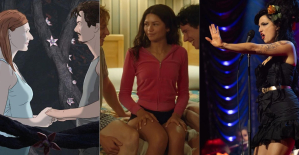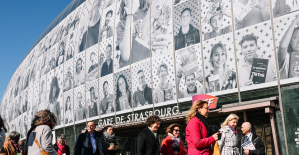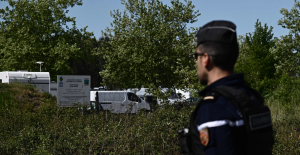Loreto is known in Europe as an Italian place of pilgrimage. This is also the name of the largest Peruvian region in terms of area, which is about the same size as Germany but only has a good one million inhabitants. Loreto is mainly covered by rainforest and is tropically warm - with an average temperature of 26.9 degrees, you are guaranteed to start sweating.
The rainy area is the origin of the Amazon: the most water-rich river on earth arises here from the union of the source rivers Marañón and Ucayali. With its rich flora and fauna, Peru's north-east, nestled between Ecuador, Colombia and Brazil, is ideal for jungle expeditions.
The starting point is usually the regional capital of Iquitos in the heart of the Amazon basin, which can be reached by ship or plane. Beautiful Art Nouveau buildings bear witness to its heyday as the center of the rubber boom in Amazonia (roughly 1890 to 1920). Many of the indigenous people were enslaved and often murdered as rubber collectors.
Today they fight against the destruction of the rainforest - many still live traditionally from hunting and fishing. Nevertheless, the jungle is cleared in many places for palm oil plantations, illegal coca fields, tropical timber industry. There are officially more than 740 indigenous communities in Loreto, who at least have a say in the country, but this does not apply to the approximately 400 communities that are not recognized by the government.
But the commitment to protecting the rainforest is also showing success: The Yaguas National Park was created in 2018, mainly at the urging of several indigenous groups. Here you can see over 600 species of birds, 210 species of amphibians and reptiles and 150 species of mammals. And there are around 330 species of fish, which is two-thirds of all fish species in South America.
Everyday life and culture of Loreto are shaped by indigenous peoples such as Achuar, Capanahua or Huambisas. Visitors can get a glimpse of their world on a tour from Iquitos of the Itaya, Nanay, and Amazon Rivers.
The Kokama, for example, have had contact with Europeans since the 16th century. Their traditions include feather and raffia ornaments, houses on stilts and a drink made from fermented cassava. On a visit to the Yagua in the Amazon, one learns how the blowgun works as a weapon. Many indigenous people work as guides, explaining medicinal plants and wildlife, such as the pink Amazon river dolphins that sometimes flash in the water.
But they also make tourists aware of the threat to the rainforest. Most recently with drastic means: In early November, indigenous people arrested around 100 vacationers on an excursion boat to demonstrate against an oil spill caused by leaking pipelines. After a day, the tourists were released.
A building by Frenchman Gustave Eiffel in the middle of the Amazon jungle? In fact, in Loreto's regional capital, Iquitos, there is a house made out of iron parts that is attributed to the creator of the Eiffel Tower in Paris, although there is no clear evidence to support this.
What is certain, however, is that the Casa de Fierro (Iron House), like Eiffel's tower, comes from Paris. There the rubber baron Anselmo del Aguila saw it at the 1889 World's Fair and bought it. Hundreds of porters dragged its individual parts through the jungle to Iquitos, where it has been since 1890 - among other colonial-style buildings worth seeing from the time of the rubber boom and within walking distance to the Amazon. Today the iron house houses a café.
If you spot a bald man with a bright red face in the jungle in Loreto, you can be happy. It is true that the Ucayali bald-headed Uakari (Cacajao calvus ucayalii) is not a beauty from the outside. His body fur looks shaggy, the tail is short, the face is reminiscent of that of an old choleric.
But the little monkey is a rare primate worthy of protection. The IUCN (International Union for Conservation of Nature) lists it as "Vulnerable", threatened by hunting and deforestation. He is extremely social. Mutual body care is extensively operated.
On the other hand, little is known about his love life; the German Primate Center and sociobiologists from the University of Göttingen are still researching the mysterious creature. It is known to eat fruits, seeds, flowers and insects and likes to live in large hordes with squirrel monkeys. The sociable animals have found a safe refuge in the Tamshiyacu Tahuayo sanctuary south of Loreto's capital Iquitos.
There are 965 species of wild plants in the Reserva Nacional Pacaya Samiria, Peru's largest nature reserve, which was established in Loreto in 1972. Many palm tree species cover large parts of the 20,800 square meter biodiversity hotspot in the Amazon jungle, which is criss-crossed by rivers. Hardly anywhere else in the world can you admire such a diverse vegetation in the tropical rainforest, including more than 20 different species of orchids, cocoa and cinchona trees.
Animal lovers will also love tours through the evergreen reserve: With over 500 bird species, it is one of the best-stocked birdwatching areas in the world. More than 130 species of mammals have also been discovered here, including the Amazonian manatee and four endangered species: brown woolly monkey, black-faced spider monkey, white-fronted spider monkey and giant otter.
“In this landscape, unfinished and forsaken by God in anger, the birds sing not; they cry out in pain"
Filming “Fitzcarraldo” (1982) in Loreto was a nightmare for director Werner Herzog, as can be read in his book “Conquest of the Useless”. Jack Nicholson was set to play the title role of the eccentric who wants to build an opera house in Iquitos. But it was too expensive.
Jason Robards jumped in, Mick Jagger played Fitzcarraldo's assistant. About halfway through filming, Robards fell ill and Jagger had to go on the Rolling Stones' world tour. The project threatened to die.
Klaus Kinski was cast as Fitzcarraldo, and Jagger's role was cut. Numerous outbursts of anger and coarse sayings ("I'll punch you in the face") have been handed down from Kinski. Allegedly, dedicated natives offered to kill Herzog at the time. The result could then be seen. Fitzcarraldo received several awards, including Best Director at Cannes in 1982 and a nomination for the Palme d'Or.
Bizarre, record-breaking, typical: You can find more parts of our regional geography series here.

 His body naturally produces alcohol, he is acquitted after a drunk driving conviction
His body naturally produces alcohol, he is acquitted after a drunk driving conviction Who is David Pecker, the first key witness in Donald Trump's trial?
Who is David Pecker, the first key witness in Donald Trump's trial? What does the law on the expulsion of migrants to Rwanda adopted by the British Parliament contain?
What does the law on the expulsion of migrants to Rwanda adopted by the British Parliament contain? The shadow of Chinese espionage hangs over Westminster
The shadow of Chinese espionage hangs over Westminster Colorectal cancer: what to watch out for in those under 50
Colorectal cancer: what to watch out for in those under 50 H5N1 virus: traces detected in pasteurized milk in the United States
H5N1 virus: traces detected in pasteurized milk in the United States What High Blood Pressure Does to Your Body (And Why It Should Be Treated)
What High Blood Pressure Does to Your Body (And Why It Should Be Treated) Vaccination in France has progressed in 2023, rejoices Public Health France
Vaccination in France has progressed in 2023, rejoices Public Health France The right deplores a “dismal agreement” on the end of careers at the SNCF
The right deplores a “dismal agreement” on the end of careers at the SNCF The United States pushes TikTok towards the exit
The United States pushes TikTok towards the exit Air traffic controllers strike: 75% of flights canceled at Orly on Thursday, 65% at Roissy and Marseille
Air traffic controllers strike: 75% of flights canceled at Orly on Thursday, 65% at Roissy and Marseille This is what your pay slip could look like tomorrow according to Bruno Le Maire
This is what your pay slip could look like tomorrow according to Bruno Le Maire Sky Dome 2123, Challengers, Back to Black... Films to watch or avoid this week
Sky Dome 2123, Challengers, Back to Black... Films to watch or avoid this week The standoff between the organizers of Vieilles Charrues and the elected officials of Carhaix threatens the festival
The standoff between the organizers of Vieilles Charrues and the elected officials of Carhaix threatens the festival Strasbourg inaugurates a year of celebrations and debates as World Book Capital
Strasbourg inaugurates a year of celebrations and debates as World Book Capital Kendji Girac is “out of the woods” after his gunshot wound to the chest
Kendji Girac is “out of the woods” after his gunshot wound to the chest Skoda Kodiaq 2024: a 'beast' plug-in hybrid SUV
Skoda Kodiaq 2024: a 'beast' plug-in hybrid SUV Tesla launches a new Model Y with 600 km of autonomy at a "more accessible price"
Tesla launches a new Model Y with 600 km of autonomy at a "more accessible price" The 10 best-selling cars in March 2024 in Spain: sales fall due to Easter
The 10 best-selling cars in March 2024 in Spain: sales fall due to Easter A private jet company buys more than 100 flying cars
A private jet company buys more than 100 flying cars This is how housing prices have changed in Spain in the last decade
This is how housing prices have changed in Spain in the last decade The home mortgage firm drops 10% in January and interest soars to 3.46%
The home mortgage firm drops 10% in January and interest soars to 3.46% The jewel of the Rocío de Nagüeles urbanization: a dream villa in Marbella
The jewel of the Rocío de Nagüeles urbanization: a dream villa in Marbella Rental prices grow by 7.3% in February: where does it go up and where does it go down?
Rental prices grow by 7.3% in February: where does it go up and where does it go down? Europeans: “All those who claim that we don’t need Europe are liars”, criticizes Bayrou
Europeans: “All those who claim that we don’t need Europe are liars”, criticizes Bayrou With the promise of a “real burst of authority”, Gabriel Attal provokes the ire of the opposition
With the promise of a “real burst of authority”, Gabriel Attal provokes the ire of the opposition Europeans: the schedule of debates to follow between now and June 9
Europeans: the schedule of debates to follow between now and June 9 Europeans: “In France, there is a left and there is a right,” assures Bellamy
Europeans: “In France, there is a left and there is a right,” assures Bellamy These French cities that will boycott the World Cup in Qatar
These French cities that will boycott the World Cup in Qatar NBA: the Wolves escape against the Suns, Indiana unfolds and the Clippers defeated
NBA: the Wolves escape against the Suns, Indiana unfolds and the Clippers defeated Real Madrid: what position will Mbappé play? The answer is known
Real Madrid: what position will Mbappé play? The answer is known Cycling: Quintana will appear at the Giro
Cycling: Quintana will appear at the Giro Premier League: “The team has given up”, notes Mauricio Pochettino after Arsenal’s card
Premier League: “The team has given up”, notes Mauricio Pochettino after Arsenal’s card


















